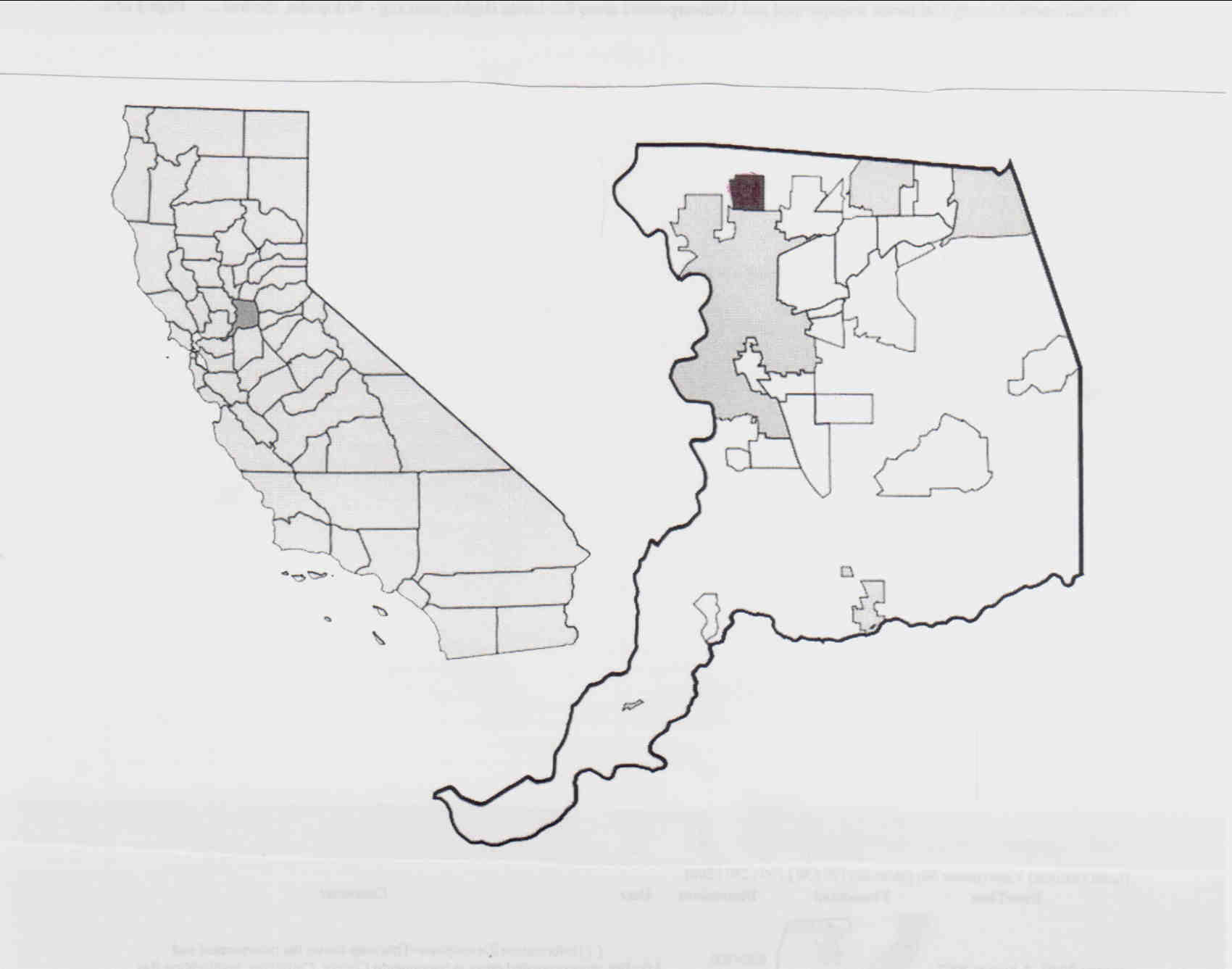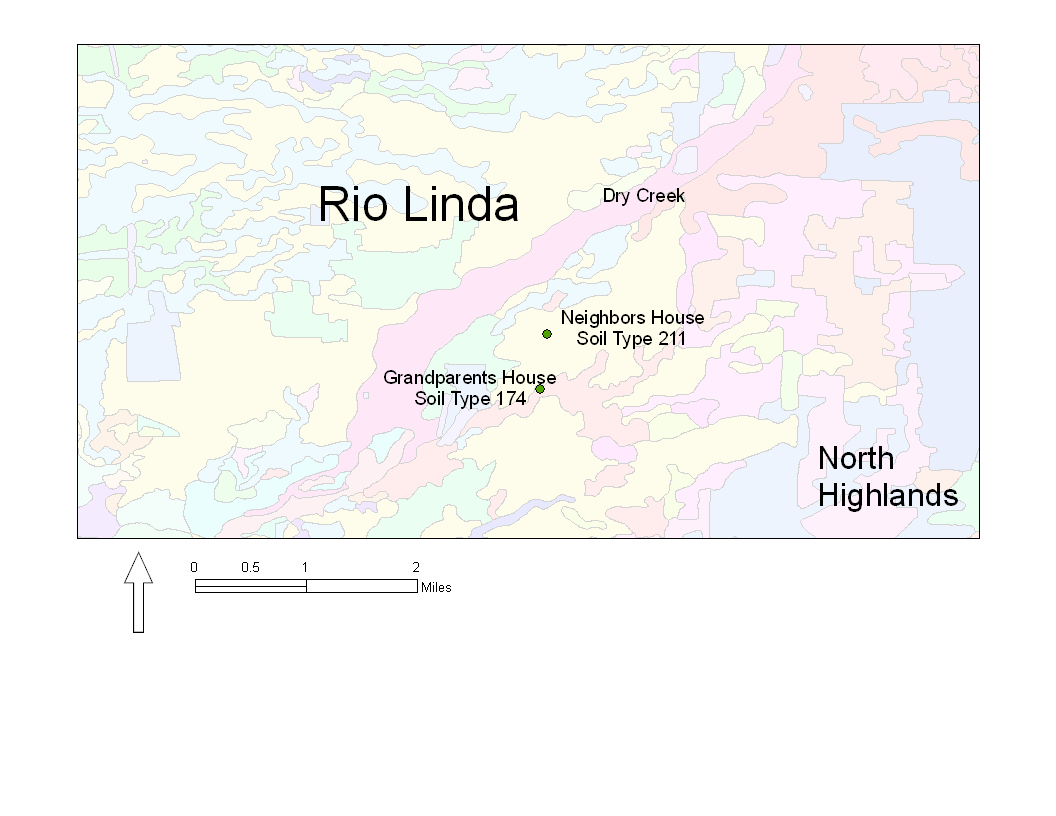Title
Verifying a Piece of Family History- A Rio Linda Land Purchase Lawsuit
Author Information
Chris Everman
American River College, Geography 350 Data Acquisition in GIS; Spring 2009
Contact Information: chris.everman@gmail.com
Abstract
In 1923 my Grandparents purchased 10 acres in Rio Linda, CA. They bought, sight unseen, based on an advertisement in a Minneapolis newspaper advertising land suitable for citrus and vineyards.
My mom said her parents joined neighbors in a law suit against the developers. They lost in court because other neighbors lied and said they were successfully growing orchards.
I looked at the soil types to see if they could account for the discrepancy in testimony. I also looked into the difficulties associated with oral histories.
I was able to verify information about the lawsuit, but not that my grandparents were a part of it.
Introduction
I had 2 purposes when I started this research paper:
1) To research the lawsuit and learn more about why my grandparents lost.
2) To research current soil maps and determine what effect they might have had if entered as evidence during the trial.
A third purpose developed as I learned more about my topic:
3) To explore the nature of oral history and how family stories are passed down.
The following information is what my mother, Elaine Elliott, has told me as part of our family history:
A. Before my mom was born, her family filed a lawsuit against a land development company, (possibly named Sacramento Vinland) for misrepresenting the land they sold.
B. The trial took place in San Francisco. My Grandparents, Fred and Emma Engen, lost, because a neighbor lied on the witness stand saying that the land was as good as advertized. She said she had a flourishing orchard ½ mile from my grandparents. She did not.
C. My mom said that her parents had never talked about the lawsuit, but she learned about it on the grammar school playground from the other kids.
D. Mom said that at the grammar school, the kids all knew whose parents sued and which parents lied. It was a ‘us vs. them’ thing. She was born in 1925.
E. My mom and the neighbor's daughter were schoolmates, never close friends, but the daughter did come to my mom's house to play a few times.
My plan for research was to start with the County Recorder's Office to learn the name of the Developer. I also interviewed several of my mom's childhood friends, went to the California Library to look at newspaper archives, and used the internet. I also wanted
to know if soil types could have been a factor in the discrepancies.
Background
Rio Linda History:
Today, Rio Linda is a rural community, north of the City of Sacramento. Its population was 10,466 in the 2000 census and they work hard to maintain their rural lifestyle.

1910 -12,000 acres are purchased by a Minnesota company eventually called Sacramento Suburban Fruit Lands Co.
1912 -The land was subdivided into 10 acre plots and named Rio Linda. A railroad flag stop was added and the first 2 families arrived.
 The original plot map for Rio Linda
The original plot map for Rio Linda
The land was advertised as prime farmland for orchards and vineyards extensively in the East- especially in Minnesota.
1914 - 9 more families arrive.
1918 - A total of 50 families have purchased plots and moved in.
PROBLEM: The farmers soon realized that the land in the Rio Linda area was not good farm land because of poor drainage. In many places there is about a foot of soil on top of hard pan. Orchards were made possible in a few places after dynamiting thru the hard
pan layer. Most of the farmers could not farm their land, and were without an income.
SOLUTION:
In 1920 the Sacramento Suburban Fruit Lands Company introduced chicken farming. They started a Cooperative, the Rio Linda Poultry Association, and hired an experienced chicken farmer as a teacher. Eventually Rio Linda became the second largest producer of eggs
and chickens in California.
In the Eastern part of the country, Sacramento Suburban Fruit Lands Company continued to advertize and sell the land as prime fruit land . Those ads did not mention chickens. At some point they also started advertising Rio Linda as land suitable for chicken
farming, (with no mention of orchards) but I do not know where or when those ads appeared.
1922 - Fred and Emma Engen saw the advertisement for prime orchard land in a Milwaukee newspaper and bought 10 acres, sight unseen. They built and lived in what later became the garage, then built a house. They tried dynamiting and planting fruit trees, but
the rain water could not drain and the trees rotted.

They lived here until the house was built. It became the garage.

The farm land flooded every winter.

Proud Dad with baby Elaine.
Lawsuits:
1928 The first case filed against Suburban Fruit Lands for fraudulently misrepresenting the land as fruit growing land was heard. The plaintiffs, Charles and Claire Elm of St Paul, Minnesota, had purchased the land in 1926. The trial lasted 6 days and the jury
awarded the plaintiffs $1,984 in damages. They also gave them clear title to the land, which had $700 owing. Nearly 50 cases were filed and the plaintiffs won all but 2 of the cases.
Methods
The GPS instrument used was a Garmin 76S. I checked the accuracy of the points by typing them into Goggle Earth and observing how close they were to the farmhouses.
Results:
My grandparent's farm is located at UTM S 0636347 4282035 and the neighbor's farm at UTM S 0636545 4282843.
I used the National Resources Conservation Service website (http://soils.usda.gov/) to determine what type of soil is present in Rio Linda. My grandparent's soil is listed as type 174, Medera loam, which occurs over 3% of the study area. The neighbors soil
is listed as type 211, San Joaquin fine sandy loam, which occurs over 47% of the study area. The descriptions of the two soil types are very similar. Drainage for my grandparents type soil is listed as being 29 to 60 inches to duripan. The neighbors soil is
listed as being 35 to 60 inches to duripan.

During my second visit to the California Library to look at newspaper archives, I met a Rio Linda historian, Margaret Posehn. She has published two books on Rio Linda history and very kindly emailed me her notes on the lawsuit. She compiled a list of more than
50 plaintiff names in the Suburban Fruit Lands lawsuit that were printed in the North Sacramento Journal. However, my grandparents names are not on her list.
Analysis:
My trip to the county recorder to determine the name of the firm who sold the land to my grandparents was unsuccessful. Although I enjoyed looking through the handwritten ledgers, I did not find the Engens listed as having bought land in Sacramento County in
the 1920's. I now believe I was looking at the wrong ledgers since I did not realize at the time that the land had been subdivided.
I talked to 3 women who had been classmates of my mother. None remembered anything about the lawsuit. Their parents had not been involved in the lawsuit so it is understandable that they did not remember. They all confirmed the poor quality of the land.
The online accounts of Rio Linda history were very helpful in providing background and the name of the land developer.
The newspaper archives for the Sacramento Bee gave details about the lawsuit. The North Sacramento Journal is not indexed, so without specific dates to look up I did not use it.
Conclusions:
This research raised as many questions as it answered.
The result of the comparison of soil types was not what I expected. The 2 soil types are described as having 29 to 60 inches of soil above the hardpan, but that is inconsistent with everything else I have read. It is possible that the descriptions are based
on today's soil and not the soil of the 1920s. My grandmother for instance, spent 50 years improving and building up her garden soil. It is also possible I may be misinterpreting the descriptions. More research is needed.
There are many possible reasons why my grandparents names were not found as plaintiffs in the North Sacramento Journal.
1. Insufficient research. The actual court documents may have more names than the paper.
2. The children who told my mom about the lawsuits could have been mistaken.
3. My mom could be remembering wrong.
4. It is possible that my grandparent's lawsuit took place earlier, as my mother remembered. IF the neighbor was paid to lie at the trial, it is possible that the newspaper was also persuaded not to publish information about it. Sacramento Suburban Fruit Lands
may have realized how vulnerable it was and made a strong effort to prevent others from filling additional suits. Later, there may have been more farmers involved and the results could not be kept quiet.
I would like to do further research about the different ways the land was advertised. If they were advertising the land at two different prices for two different purposes at the same time, this could have been a factor in the success of the lawsuits.
Even if my Mom was mistaken about her parents being in the lawsuit, it was still a worthwhile research subject. She still grew up believing that they had been unfairly treated and that the neighbor had lied without consequences. Therefore, it affected her relationships
and belief system.
My experience with this research has illustrated some of the problems that can arise with oral history. Facts are hard to verify, the account is very subjective, and there can be issues with memory loss. Several of the minor details in my mom's account were
either inaccurate or could not be verified.
“As with any source, historians must exercise critical judgment when using interviews—just because someone says something is true, however colorfully or convincingly they say it, doesn't mean it is true. Just because someone “was there” doesn’t mean they fully
understand “what happened.”Linda Shopes, “Making Sense of Oral History,”
References:
http://myriolinda.com/index.html History and Links
http://www.cityofsacramento.org/ccl/history/SacHistoryOnline/history.html
http://www.sacramentohistory.org/search.php
Posehn, Margaret, 2008, Rio Linda and Elverta History 1850-1929
Shopes, Linda "Making Sense of Evidence series on History Matters": The U.S. Survey on the Web, http://historymatters.gmu.edu

 The original plot map for Rio Linda
The original plot map for Rio Linda 


